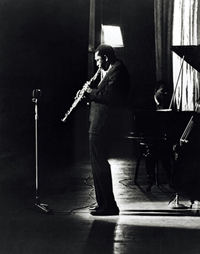
John William Coltrane was born September 23, 1926. Widely recognised as one of the most prolific and influential jazz musicians he influenced innumerable musicians, and remains one of the most significant tenor saxophonists in jazz history. He received many awards, among them a posthumous Special Citation from the Pulitzer Prize Board in 2007 for his “masterful improvisation, supreme musicianship and iconic centrality to the history of jazz.”
He was beatified by the African Orthodox Church as Saint John William Coltrane. His maternal grandfather, the Reverend William Blair, was a preacher. As a youth, he practiced music in a southern African-American church. The spiritual influences of his early life would follow him throughout his career. Following his marriage in 1955 to Juanita Naima Grubb, a Muslim convert, (for whom he later wrote the piece “Naima”), he came into contact with Islam. Within two years his religious ideas were shifting along with his addictions to alcohol and heroin. He explored Hinduism, the Kabbalah, Jiddu Krishnamurti, African history, and the philosophical teachings of Plato and Aristotle. In the liner notes of A Love Supreme Coltrane states “during the year 1957, I experienced, by the grace of God, a spiritual awakening which was to lead me to a richer, fuller, more productive life. At that time, in gratitude, I humbly asked to be given the means and privilege to make others happy through music.” In his 1965 album Meditations, Coltrane wrote about uplifting people, “…To inspire them to realize more and more of their capacities for living meaningful lives. Because there certainly is meaning to life.”
Moustafa Bayoumi, an associate professor of English at Brooklyn College, City University of New York, argues that Coltrane’s A Love Supreme features Coltrane chanting, “Allah Supreme.” In October 1965, Coltrane recorded Om, referring to the sacred syllable in Hinduism, which symbolizes the infinite or the entire Universe. Coltrane described Om as the “first syllable, the primal word, the word of power”. The 29-minute recording contains chants from the Bhagavad-Gita, a Hindu holy book. A 1966 recording, issued posthumously, has Coltrane and Pharoah Sanders chanting from a Hindu text, Bhagavad-Gita, and reciting a passage describing the primal verbalization “om” as a cosmic/spiritual common denominator in all things.
Coltrane’s spiritual journey was interwoven with his investigation into world music. He believed not only in a universal musical structure which transcended ethnic distinctions, but in being able to harness the mystical language of music itself. Coltrane’s study of Indian music led him to believe that certain sounds and scales could “produce specific emotional meanings.” According to Coltrane, the goal of a musician was to understand these forces, control them, and elicit a response from the audience. Coltrane said: “I would like to bring to people something like happiness. I would like to discover a method so that if I want it to rain, it will start right away to rain. If one of my friends is ill, I’d like to play a certain song and he will be cured; when he’d be broke, I’d bring out a different song and immediately he’d receive all the money he needed.”
Coltrane helped pioneer the use of modes. A “scale” is an ordered series of intervals that, with the key or tonic (first tone), defines that scale’s intervals, or steps. However, “mode” is usually used in the sense of “scale,” applied only to the 7 specific diatonic scales (using only the seven tones of the scale without chromatic alterations) that follow the tonic note. The use of more than one mode makes music polymodal, as with polymodal chromaticism. Modern musicological practice has extended the concept of mode to earlier musical systems, such as those of Ancient Greek music and Jewish cantillation, as well as to non-Western musics
Coltrane died from liver cancer at Huntington Hospital on Long Island on July 17, 1967, at the age of 40.

